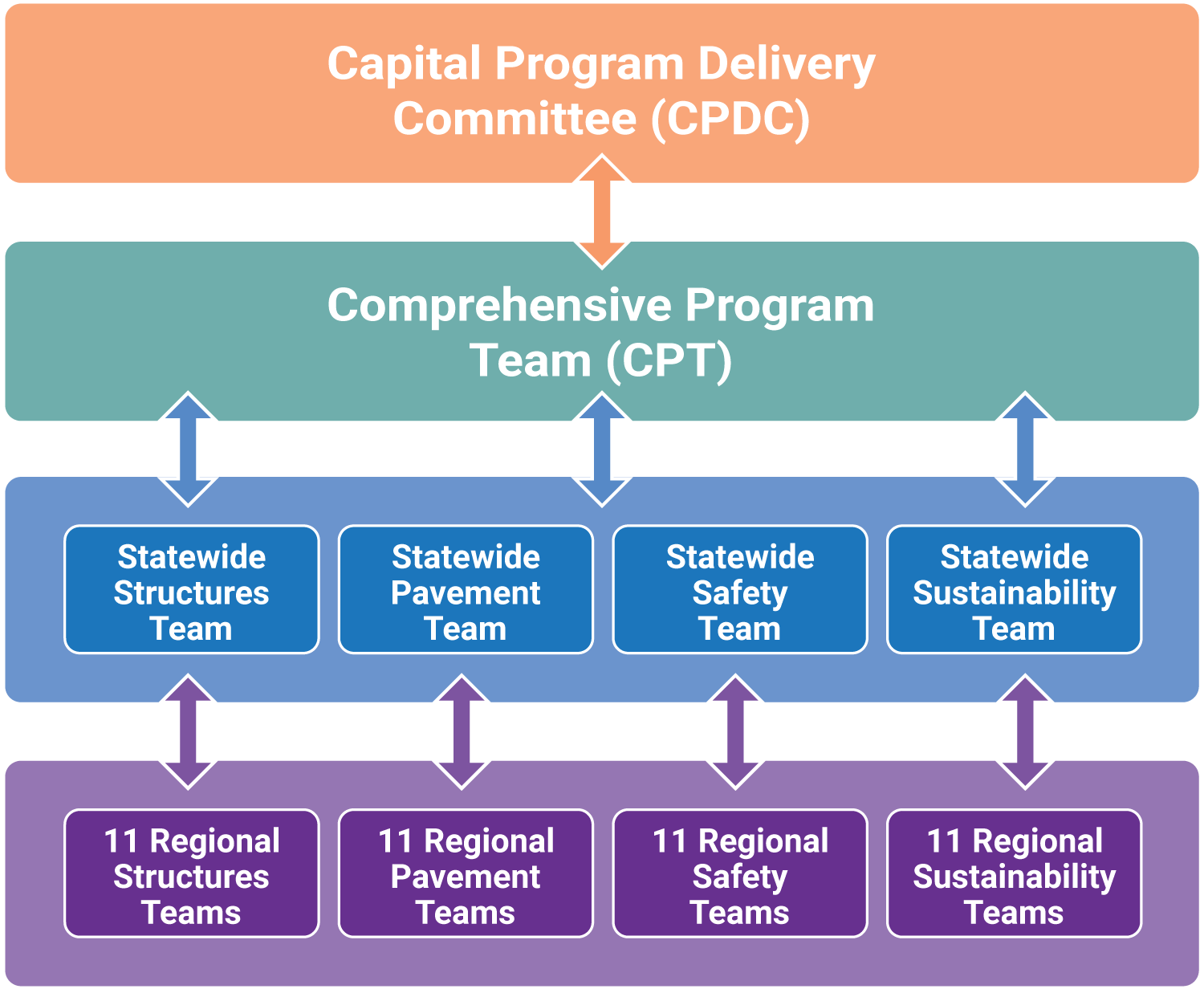- Chapters
-
Chapter 3
Sections - Chapter 3 Home Page
- Chapter PDF
Chapter 3
Quick Links
3.2.1
Internal Coordination
Different business units in an agency contribute to the TAM process and are crucial to its success. Many TAM activities depend on internal agency coordination, including: drafting TAM policies that impact units throughout the agency; establishing performance targets for asset condition; developing the TAMP; and prioritizing projects and initiatives. The agency’s planning, programming, project development and delivery, maintenance, and other units must coordinate to make TAM work.
TAM-Related Committees
This section touches on the importance of internal coordination committees across the various TAM-related activities. The form of committees is directly related to the agency’s organizational model. These coordination committees are focused on coordination across functions. The coordination committees with important roles in TAM decision-making include:
TAM Steering Committee
This is a senior-level committee made up of top decision-makers. They provide strategic oversight for TAM and facilitate resourcing and organizational support for agreed-upon changes. They also make sure that the politics of any decision are considered. The How-to Guide Establishing a TAM Steering Committee provides steps to set up this function.
Asset Stewards Committee
This is a committee consisting of individuals with accountability for different asset. It provides a forum for getting agreement on standardized approaches, enabling a holistic view of the TAM program, communication about management practices, and discussions about coordinating project development and work planning.
Asset Data Governance Committee
This committee focuses on improving data for TAM. Its activities may include: coordinating asset data collection activities; developing standards to enable integration of data about different assets; monitoring and facilitating adoption of existing standards; establishing data quality management processes; and advancing investments in tools for field data collection, data analysis, reporting and visualization.
TAM Working Group
This group is composed of unit managers across the agency who deal with key aspects of the TAM process – planning, programming, delivery, maintenance, data management, communications, etc.
Coordinating across TAM committees is also an important function. Typically the TAM lead will make sure the activities of various TAM committees are coordinated. In some agencies, the governance across the committees are explicitly stated so that everyone understands who is doing what and how decisions across committees are related.
TIP
Forming a new set of committees to provide TAM coordination is not always the best approach. Some agencies can rely on their existing management structures. Others may already have committees set up to facilitate cross-unit communications. Smaller agencies may be able to rely on informal communication. What is most important is that the TAM program gets the results it seeks.
TIP
When forming a committee, it is important to limit the overall size of the committee to the smallest group needed to accomplish its objectives. Common practice is to limit committees to no more than 12 members.
New Jersey DOT
The New Jersey DOT TAM Steering Committee is comprised of NJDOT senior leadership. The committee sets policy direction and provides executive oversight for the performance management of the state highway system. The Transportation Asset Management Steering Committee provides general direction to the TAMP effort and assists in communicating the purpose and progress to other stakeholders.
New York State DOT
NYSDOT‘s TAM program is made up of a set of teams that perform TAM-related activities. They use TAM as an all encompassing set of principles that are embedded in activities they perform to make and deliver investments that provide mobility and safety to the traveling public. The TAM program coordinates inside the agency to ensure that TAM is being implemented as efficiently and effectively as possible. The following diagram illustrates the inter-relationships and communication that occurs across functional and geographic teams to make TAM work.
Source: Adapted from New York State Transportation Asset Management Plan. 2018.
Ohio DOT
The Ohio DOT Asset Management Leadership Team is a cross-disciplined team, with representatives from all major business units, that establishes data governance and data collection standards. A sub-group of the Leadership Team, the TAM Audit Group, is then responsible for overseeing all asset data related requirements, and making sure standards are in place and processes are followed. This group reviews and approves all data collection efforts and ensures that efforts are coordinated across the DOT. Having designated roles and responsibilities in regards to data governance and collection allows the agency to identify all potential customers of the data being collected and ensure that the data is sufficient to meet all relevant asset management needs.
The Ohio DOT deploys a hierarchy for managing TAM data collection.
- TAM data priority is established by the Governance Board (Assistant Directors)
- The Asset Management Leadership Team (AMLT), which is a cross-discipline team of representatives from all major business units, develop strategies and collaboration opportunities to achieve Governance Board directives
- The TAM Audit Group (TAMAG) perform business relationship management by working with data business owners, SMEs, and stakeholders to create enterprise TAM data requirements
- The Central Office GIS team utilizes the completed TAMAG business requirements to create data collection solutions
- The District TAM Coordinators provide oversight, support and coordination for data collection solution implementation, operations and performance

